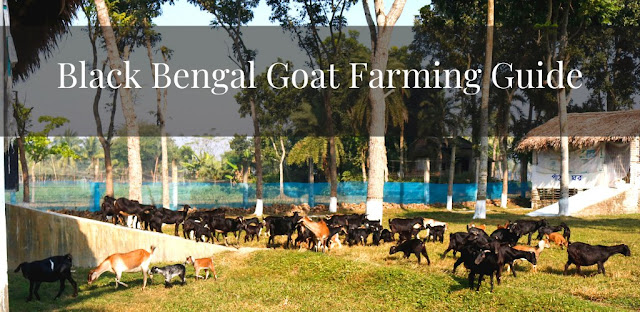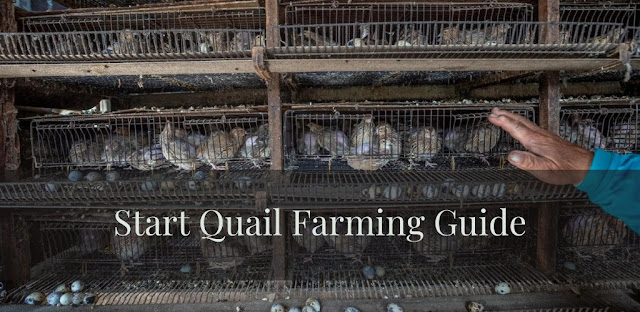How to Start Black Bengal Goat Farming
Black Bengal is one of the important breed due to its high prolificacy, early maturity, low kidding interval as well as for their delicious meat and high quality black skin.
The breed is locally known as „Deshi‟ Goat. It is normally distinguished from other breeds by its certain prominent physical characteristics, viz., small size, deep body, short legs, thin and shiny hair coat. Internationally the breed is famous as „Bengal Goat‟. The breed possesses different pure and mixed colours, amongst which black and black combined with mixed colours are most frequent with certain amount of regional variation. As a consequence the breed is often known as "Black Bengal".
Black Bengal Goat - Breed Characteristics
Physical characteristics:
It is small-legged goat. Shoulder and hips are of equal height. Chest is wide with deep body. Body looks triangular from side in females, with heavier posterior region. This character is less prominent in males.
Face is comparatively short in males with strong and well-built neck and shoulder. Ears are nearly upright. The animal possesses soft but short hair.
Head profile: Three types of head viz., straight, convex and concave are noticed in the breed. Majority of the animals posses straight head, followed by convex and concave type.
Wattles: Presences of wattles in the breed is low. Wattles bearing animals are mostly found in Midnapore and Malda area.
Beard: Bengal goats are also found to have beard in few cases particularly in old ages.
Long body hair: Generally hair coat of the breed is thin, smooth and shiny as required for higher heat
Tolerance, However few members of the breed are found to possess long hair in some body regions, viz. shoulder, thigh, back, thigh-back, leg and tail.
Coat colour: Bengal goat possesses both pure and mixed coat colours. Pure colours are black, white, brown and gray. Mixed colours are formed by the combination of any two of the pure colours. Prevalence of black coat colour is maximum and for this reason the breed is often misnomer as "Black Bengal".
Among different mixed colours, prevalence of white-black colour is maximum. The breed possesses a smooth, shiny and thin coat.
Colour variation in Eyes, Muzzles and Hooves: In addition to coat variation, variation of the colour pattern of eyelid and eyelash, nose and muzzle and hooves is also present.
Eyelid and Eyelash: In conformity with prevalence of coat colour, maximum goats having with white eyelid and eyelash, however, black is the commonest colour pattern. Rest of the colour patterns is very less in frequency.
Nose and muzzle: The maximum number of goats has black nose and muzzle. Rest of the pure and mixed colours are less prevalent in the population.
Hooves: White, Black, brown and grey are the different hoof colours in the population. Quite naturally, black hoof is the most common.
Ear: Wide variation is observed in the ear phenotype of this breed. Ears are either erect or pendulous. However up to 10 cm in length, ears are mostly erect types. When length is more than 10 cm, relative proportion of pendulous type increases. No sex difference is apparent either in length or type of ear. Though length of ear increases along with age, yet beyond 12 months of age almost 80% of animals have 10-15 cm ears.
Horn: Two types of horn, viz., curved and straight are found in Bengal goat. Females are horned but relatively shorter. Majority of the horns are straight and within 5 cm in length. Though, in animals beyond one year of age, horns of larger length are not uncommon.
Tail: The breed possesses short tail (5-15 cm). Though tail length increases along with age, yet tail beyond 15 cm is very uncommon. Sexual dimorphism in tail character is generally not prevalent.
Bengal Goat farmer: Majority of the Bengal goat farmers belongs to the weakest section (either labourer, landless or marginal farmer) of the society. As the prevailing Bengal goat production system requires no classical resource, it is most popular as a supplementary source of family income.
Bengal Goat flock information: Smallest size flocks (up to 4 animals) are most common in all regions and flocks with more than 8 animals are very limited. This is all probably due to growing scarcity of natural pasture or natural feed resource for their flocks and due to gradual intensification of cash crop production. Farmers are to depend on grazing (either free or tethered) only as the breed is not adapted to stall feeding completely. It has also been found that stall-feeding is also not feasible economically for this breed for its low daily gain.
Flock Composition: The proportion of males generally reduces sharply beyond 24 months of age. Only few males are retained in the flock are used exclusively for breeding purpose. Castrated (male) animals also constitute a substantial group in the population due to higher market demand over entire (male) animals as chevon producer.
Housing of Bengal goat: Bengal goat is housed mainly for night shelter as well as during inclement weather. Though Bengal goat is typically a grazing animal, yet farmers keep in-house arrangement for feeding and watering for supplementary feeding and feeding during inclement weather. Farmers generally used varieties of materials (like bamboo, paddy straw, earthen tiles, tree leaves etc) for construction of goat house.
In few cases brick in earthen or cement mortar is also present. Two major designs is available viz., (i) open with only roof and little side walls, those can be covered completely either with gunny bags or tree leaves and (ii) covered with four walls, doors and windows like opening. Many goat farmers also rear other domestic species under composite farming system. Bengal goats are housed either separately or with other animals or along with human being in their residence. Bengal goats are mostly managed by free or tethered grazing depending upon season and the availability of pasture. Only during raining, farmer try to provide the animals with lopped tree leaves in-house.
In-house feeding management: Arrangement of in-house feeding within goat houses also provided. The farmers used bamboo basket, Metal tub, Bucket and Jute bag as manger.
Drinking water management: Farmers also routinely practice supplying drinking water to goat either once a day during winter or twice a day during summer months. But during grazing drinking of water by the goats has been made from different natural sources, viz., rivers, ponds, ditch, irrigation cannels, paddy fields etc.
Special housing: Bengal goat, particularly young ones are found susceptible to pulmonary infection. Hence, more elite farmers, if not constrained by finance, prefer to provide their animals with special housing during stressful seasons and during parturition. Farmers prefer to confine both mother and neonates in-house or adjoining areas. The duration of confinement varies from zone to zone as well as from season to season. Farmers need to arrange for feeds and fodder, tree leaves during the period of confinement, which is otherwise managed by grazing.
Additional facility in Bengal goat houses: Bengal goat tract being located in hot-humid areas is subjected to high mosquito menace. Farmers being fully aware of harmful effect of mosquito provide their animals with mosquito net and light to give protection to their animals. However, use of these two facilities is limited by shortage of fund with the farmers.
Feeding management:
Bengal goats are managed mainly by grazing and stall feeding in few cases. Animals are stall fed or grazed in phases, viz., morning, noon and afternoon. Animals are stall fed with harvested natural grasses and lopped tree leaves. Bengal goats are not normally habituated with dry fodder. Common tree leaves used are Banyan, Mango, Tamarind, Babool etc. The duration of grazing (5-6 hours) in different shifts, viz., morning, noon and afternoon are different. Duration is minimum during noon.
However, the practice was found to be identical in different seasons. Animals usually covered about one sq. km area daily for grazing. Animals are subjected to free grazing, tethered grazing, free grazing in presence of keeper and both free and tethered grazing. Farmers used tethering rope in case of tethered grazing. Harvested crop fields and their boundaries is the major pasture for Bengal goat.
Farmers also practiced supplementary feeding of their animals in different season depending upon their ability to procure to feed supplements. Common feed supplements used are concentrate, natural grasses, tree leaves and miscellaneous items in different combination.
During rainy season, when scope of grazing becomes limited due to raining, maximum number of animals is supplemented with grasses and tree leaves. Grasses and tree leaves are the most commonly used items as feed supplement.
Cek also Black Bengal Goat Farm Guide App.
Farmers have three sources for grass and tree leaves, viz., cultivated, purchased and natural. But majority of the farmers depended on natural sources only. Supplementary feeding of sucking and weaned kids also common. Kids suckled their mother for about 3 month. In most cases kids are allowed to graze with their mother.
Milk, rice gruel, barley and miscellaneous items were the types of feed supplements used in case of suckling kids. Milk used as supplements are from cattle or buffalo as milk production of Bengal doe is very less and often it is found to be critically less in case of triplet or quadruplet born kids.
Rice gruel, a common kitchen by product of West Bengal was also a very common feed supplement for sucking kid/goat. Weaned kids are provided with supplementary feed like grass, concentrate and miscellaneous materials. However, the practice did not vary much from season to season.

.jpg)


Komentar
Posting Komentar